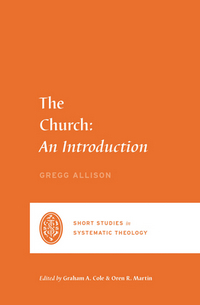 |
The Church: An Introductionby Gregg Allison Paperback, 164 pg. Read: October 10, 2021 |

What’s The Church: An Introduction About?
Allison starts with a good Introduction, sketching the ambiguity of the current English term “church”—driving home the need for a book like this. He then spends two chapters with the foundation—outlining both the relationship between the Trinity and the Church and then with a broad overview of the Scriptural doctrine of the Church.
Then he moves into the bulk of the book:
I will present the church in terms of its local expression according to the following topics: identity, leadership, government, ordinances or sacraments, ministries, and future. For each topic, the first section—mere ecclesiology—presents the common ground shared by most churches throughout history. This aspect addresses the essence, or core, of the church’s identity, leadership, government, ordinances or sacraments, ministries, and future. The second section—more ecclesiology—describes how this essence expresses itself in the actual identity, leadership, government, ordinances of sacraments, ministries, and future of particular churches.
So, what did I think about The Church: An Introduction?
In summary, ecclesiology properly begins with a consideration of the doctrine of God. Specifically, it is grounded in Trinitarian theology, which leads to this conclusion: There is one people of God, who from eternity past has graciously elected all those who will believe in him by faith and walk with him in obedience, worship, love, and service. This one people of God consists of two aspects: the people of Israel in old covenant relationship with him and the people of the church in new covenant relationship with him. Specifically in regard to this second aspect, the church is the body of Christ and temple of the Holy Spirit. As the body, the church submits to its head, celebrates its diversity of people and gifts, lives out its siblingship in all purity, and portrays and fosters its unity by participation in the Lord’s Supper. As the temple of the Holy Spirit, the church in which he dwells is birthed, empowered, gifted, directed, sent, and sanctified by the Spirit.
The first couple of chapters got me excited for the book, and then after that, each chapter annoyed me more. He totally squandered that start—the “Mere” portions of the chapters were generally decent, but far too short. The “More” portions on the other hand…didn’t belong in a book like this (for the most part)—to get into all my problems would involve getting into the nitty-gritty of the arguments. They seemed to be what he wanted to write about more than the “Mere” bits and aren’t really introductory ecclesiology.
Also, and this is just one of those things, one chapter felt like it was written in response to my pastor’s sermon that day—each point seemed to be counter one of his (or vice versa). I was already having issues with the book, but that might have been the straw that broke the camel’s back for me. (not that I think my pastor is infallible, it was just bad timing—and a bad take on the text)
If this was the first book in the Short Studies in Systematic Theology that I’d read, I probably wouldn’t have come back for more. But, as it’s the fifth, I can keep going, trusting that this was a fluke.
In the end, I think this book tried to do too much. It tried to be all things to all people rather than embracing a confessional point of view as well as getting hung up on the structure, and ends up not accomplishing much at all. Focusing on and fleshing out the “More” portions would’ve made for a better read, a more profitable read, and a less problematic read. File this one under “don’t bother.”

This post contains an affiliate link. If you purchase from it, I will get a small commission at no additional cost to you. As always, opinions are my own.
![]()



2 Pingbacks